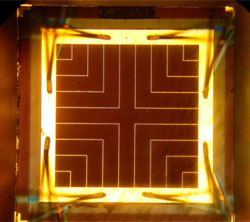Dual-Junction Solar Cell Sets World Efficiency Record at 32.6 Percent at 1000 suns
Posted On Friday, January 2, 2009 at di 8:10 PM by AndriThe III-V Semiconductors group of the Instituto de Energía Solar at Universidad Politécnica de Madrid (IES-UPM) in Spain has set a new record for solar energy conversion efficiency of 32.6% for a dual-junction photovoltaic cell.
Designed and fabricated in a horizontal MOCVD reactor by IES-UPM’s III-V Semiconductors group, the lattice-matched dual-junction solar cell was independently measured at the calibration laboratory of the Fraunhofer Institute for Solar Energy Systems (FhG-ISE) in Freiburg, Germany. The 32.6% efficiency was measured under light concentration of 1026 suns (where one sun is the amount of light that typically hits the Earth on a sunny day), while at 2873 suns the efficiency is still 31.1%.
Professor Carlos Algora, director of the group, says that the new cell is an important advance for terrestrial concentrated photovoltaic (CPV) modules, which use lenses or mirrors to focus sunlight onto the solar cells.
IES-UPM says that its new solar cell differs significantly from the previous record holder, made by Fraunhofer ISE (which, in 2000, achieved 31% at 300 suns). It adds that the importance of the new record is not only the efficiency increase of 1.6%, but also the concentration level (1026 suns versus 300 suns). As a rule of thumb, the higher the concentration, the lower the resulting price of the generated electricity. IES-UPM reckons that, after about five years of development, the cost of solar electricity from CPV systems based on this type of solar cell would be about 5.5c€/kWh, while at present the cost of electricity in Spain (generated by all available sources: nuclear, oil, coil, gas, renewable etc) is about 7.5c€/kWh.
Algora stresses that this record dual-junction solar cell represents a step towards improving the efficiency of triple-junction solar cells, for which the efficiency record of 40.8% was achieved under concentration of 300 suns by the US National Renewable Energy Laboratory (NREL). Researchers in the IES-UPM’s III-V Semiconductors group think that integration of its dual-junction structure into a triple-junction solar cell could result in a device with efficiencies of more than 41% at 1000-sun concentration.
by Jlbrice








